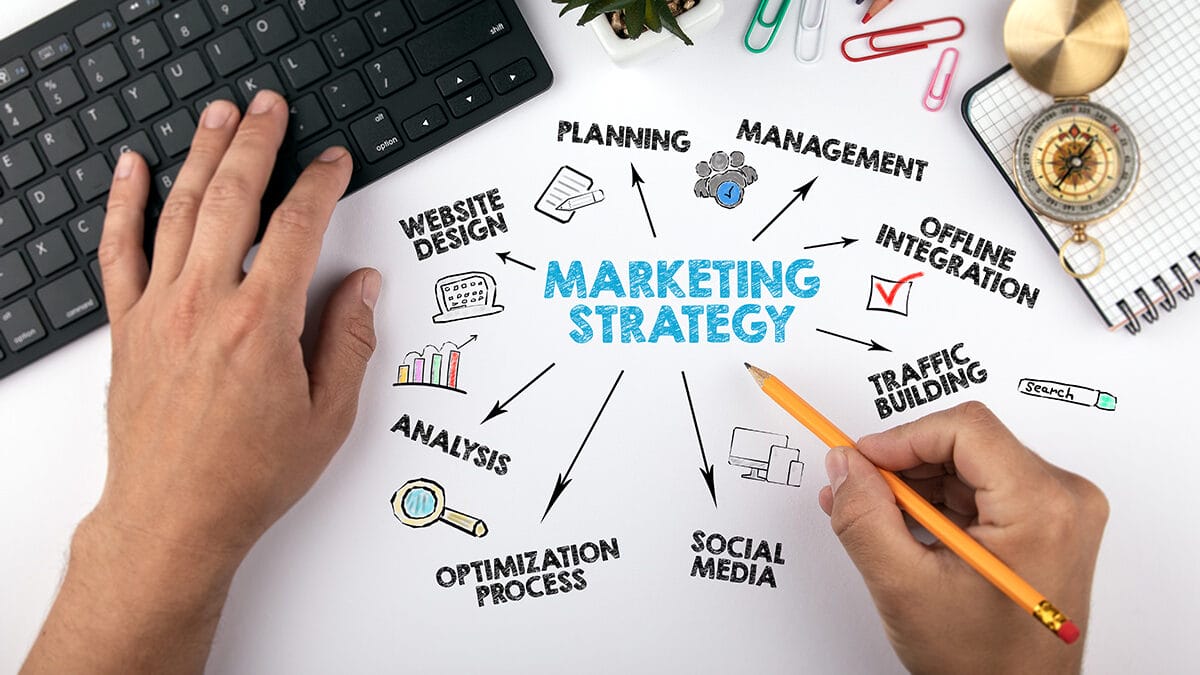Many businesses struggle with traditional marketing practices. Conventional marketing strategies and campaigns lead to some extent of failure when brands don’t invest sufficient budget in their campaigns. Not every business can manage to invest high bucks in their marketing campaigns, and that’s where digital marketing completely dominates traditional marketing measures.
Digital marketing has enabled businesses to target a global audience by ensuring their international customers see and acknowledge their content and brand. With this, brands can get more in return for investing much less and can get more opportunities to scale and promote their brand on several digital platforms.
“The Digital Advertising market is expected to see ad spending climb to $740.3 billion in 2024.”Statista
Why Digital Marketing Matters?

In today’s highly competitive world, it has become essential for businesses to take the necessary steps to stay ahead of the competition. One of these essential steps is to consider digital marketing.
Regardless of the industry you are in, digital marketing may benefit your business in many ways. In fact, it can make a difference to your success, especially if you combine it with traditional marketing. But why is digital marketing important?
Digital marketing is one of the reasons businesses are leaving traditional practices and going for a more convenient approach. Some of the benefits of digital marketing are as follows:
Helps to Monitor Your Campaigns and Optimize Them
With digital marketing, brands have a clear overview and knowledge of how their certain campaigns and strategies are working. Unlike traditional marketing brands, which don’t have a clear view of how their campaigns are working and resonating with their prospects. However, with digital marketing, brands have access to different performance analytics tools to measure their website traffic, leads, and conversion rates.
Once you invest your money and time into your campaigns, you might like to know that they’re working. With digital marketing, it’s easier to track all of your campaigns, enabling you to drive better results and adapt to the latest trends.
If you’re using traditional digital marketing methods, it’s challenging to know your campaign’s results. If you’re running a TV ad, for instance, you might need to ask every person who may come into the store regarding what made them transact with your business. It’d be a time-consuming effort, which can also annoy those who visit your business.
By considering digital marketing, all of your campaigns can be easily tracked and you can also check the metrics like clicks and impressions. With such metrics, it’ll be hassle-free for you to know which campaigns work and which don’t for your business.
Allows You to Target More People
Traditional marketing includes radio, newspaper ads, and TV ads. Although publicity is good in such methods, they’re not that effective since only a few people listen to the radio, read ads in the newspapers, and watch ads on the TV.
“In these modern times, more people rely on mobile devices and computers because of the internet. With this in mind, there’s no doubt digital marketing is essential these days, especially if you want to target a wider audience and get your business exposed, not just locally but globally.”William McKee, the Managing Partner of Knowmad
Traditional marketing usually prevents users from reaching more areas and customer bases. After some time, brands feel a slump in their reach and usually face certain hurdles to reach their audience. Through digital marketing, brands have access to a global audience and can sell their services to customers living on the other side of the world.
Can Help You Stay Ahead of Your Competitors
Most of your competitors are already online, and so should you. Regardless of how big or what type of business you’re running, it’s important to incorporate digital marketing. The reason behind it is that every business can increase its presence over the internet, which may come in handy to beat your competitors and target your niche audience.

Digital Marketing is More Cost-Effective
Running a business can be expensive, most particularly if you’re stuck with traditional marketing. Fortunately, with digital marketing solutions, marketing is more cost-effective.
If you’re on a budget and just getting started, you can quickly market yourself on a national, local, or global level without spending a lot of money. That’s why, for better results, small business owners use digital marketing to their advantage.
Provides New Ways to Earn Money
At present, some people earn cash just by uploading YouTube videos, taking online surveys, and writing blogs. So, if you don’t want to focus on your online business only, there are other ways to earn more.
Depending on your preferences, you may create videos that highlight your products or services on YouTube. Once you gain more subscribers and your views continue to increase, you’ll earn extra income in no time.
In the world of digital marketing, content writing is also popular. If you love writing articles on any topic under the sun, you can earn money from being a content writer. The fees for content writing services may vary from one client to another. It also differs from the type of content being requested by clients – it can be website content or blog articles. Thus, it’s crucial to determine which content you’re most comfortable with.
Integrates with Mobile Technology
As years pass by, mobile transactions continue to increase. However, it isn’t just the actual selling and buying happening on mobile. Many people use their mobile devices as a type of augmented reality layered on a business. They look at product information and reviews while in your store. They also order online or communicate with customer support en route.
If you’re a business owner and you start integrating mobile experience with physical experience, your business will be able to benefit from many opportunities, like more exposure and better promotion.
With digital marketing, it’s easy to send alerts to your target audience about your current deals or offerings. They can easily find your physical store if they want to visit it through geo-location.
Easy to Scale and Adapt
As with any kind of marketing, there’s an initial investment needed to get traffic flowing. However, the significance of digital marketing to small businesses becomes clearer once you see how easy it is to adapt and scale as your business grows.
For instance, through social media campaigns, search ads, and display ads, you may choose your daily budget. This will give you an idea of how much your campaign may cost you while being able to see results through analytics.
The good thing about digital marketing is that you can always make some changes to your campaigns and re-launch them without the need to start from scratch. With the data that you can easily access, you can make some fast changes to lessen lost revenues and wasted ad spending.
Digital Marketing Can Be Hyper-Personalized
With digital marketing, it’s easy to target the individual level. This can be referred to as segmentation but there are times that marketers call it personalization.
Most consumers prefer businesses that use email to communicate with them. This is because it provides people a sense of control, making them more comfortable signing up for emails and purchasing from you. If they don’t love what you’re sending them, they’ll just unsubscribe.
However, if you send them content that’s relevant, they may stay on your list and continue purchasing over and over again. That’s why digital marketing can be beneficial if you want to get repeat lifetime customers.

There are some basic marketing tools that can let you add a customer’s contact details automatically to emails. With some digital marketing tools, like CRM, it’s easy to collect data about every email subscriber. You can use the data to subdivide your list based on particular behaviors or traits identified through analytics. Once divided, sending relevant content to a certain group of individuals can be done with ease.
Digital marketing also enables personalization that allows you to recognize your customers on an individual level. This means that you can quickly recommend the finest products to them since you already know their purchase history. You can also recognize the pages they visited on your website and what products are still in their cart.
This is why digital marketing is never hard to be personalized in accordance with your customer’s needs and business goals.
Aligns with How People Shop Today
These days, most people read and focus on online reviews when finalizing their buying decisions. The reason behind this is that reviews allow them to have a better understanding of what the services or products do and how such products can benefit them.
In addition to that, more people do online searches instead of watching TV to discover trending items. There are also only a few people who still read magazines and newspapers. For this reason, having an online presence and taking advantage of digital marketing can make a difference. If you have a well-optimized website, it’ll be easily discovered by users whenever they look for relevant keywords.
The more integrated your company is with the online experience of your customers, the easier you’ll be able to grow your business. An online presence is essential to be relevant to your customers and that’s never impossible if you’ll incorporate digital marketing.
Improves Your Credibility
Nowadays, most people use the internet to check for certain things; like the history of a company and the reviews of the customers for particular products. If your business or brand is nowhere to be found online, you might have a hard time getting the attention of your target audience.
Another reason why digital marketing matters is that your online presence will increase, which may also help you gain the trust of your customers. With this kind of marketing, it streamlines your business like having your own website or accounts on social media platforms.
Through your online presence, your audience or potential customers will have the convenience when they’re getting to know your business and the products or services you’re offering. This may also improve your company’s credibility and give your customers the confidence to purchase your offerings.
Provides Comprehensive Access to Data
Digital marketing helps businesses find their ideal prospects with detailed data analysis. With this, brands can get detailed analyses and records of their marketing campaigns. These data analogies and responses on certain data sets give marketers a complete overview of how their strategies and campaigns are working. This gives them ideas on how to customize their strategies for various customer segments.
The Ultimate Checklist of Digital Marketing

If you want to make it big in the industry, you need solid marketing services. However, with the constantly evolving digital world, things are rapidly changing and it’s difficult to say what works. This brings me to the dictum “The more things change, the more they remain the same”.
And in our world, this means that the staple digital channels you use to market your product and build your brand will continue to be what we’ve outlined below. Of course, the techniques have changed – Google has changed its algorithm to weed out weak content, Facebook does more algorithm-based newsfeeds than curated ones, and social media sites have updated themselves to remove spammy links. Each platform is progressing, but the set of platforms is still largely the same.
However, like any other method of marketing, it is crucial to comprehend how digital marketing works, and how it can be implemented to grow your business. In order to get maximum results from digital marketing, any business needs to keep the following points in mind:
- Target audience: You need to know the kind of audience for which you want to create the online marketing strategy. It can save time as well as resources. By going online, you also create awareness among people who are unaware of your business presence.
- Kind of content: Content is king in the digital marketing sphere. It is the foundation for any successful business and can bring traffic to the company’s website to convert leads into customers. Articles, blog posts, press releases, infographics, etc. are some of the forms in which content can be presented.
- Select the right platform: In order to pitch your business or services, you need to select an appropriate platform. Social Media, Mobile Platforms, and Paid Marketing are quite popular. You have to create strategies according to the specific platform to engage a larger audience.
If you’re not using the best expertise available for leveraging these channels, you’re making a huge mistake. So, here we go – some of the main pillars of digital marketing are:
1. Search Engine Optimization (SEO)
Search Engine Optimization (SEO) optimizes the website to ensure its content and priority pages rank on top of Search Engine Result Pages (SERPs). Google differentiates high-performing content from low-performing content with the help of algorithms. These algorithms look for several things on a page that has content.
Google updates these algorithms frequently, and to adapt to these changes, business owners need to change their SEO strategies to compete with the competition. If done correctly, SEO can take your website to the first search engine results page, bringing you heaps of organic traffic.
Search Engine Marketing (SEM) is evolving rapidly in the digital marketing field. It is a kind of internet marketing in which the promotion of websites is done by increasing visibility in SERPs using paid advertising. Any digital marketer can adjust or rewrite content and site architecture to attain a higher ranking in search engine results pages. Additionally, it also boosts pay-per-click (PPC) listings. We will discuss some of them later in this article.
A well-structured strategy usually involves:
- Keyword Research.
- Content Creation and Optimization.
- Managing internal and external linking outreach.
SEO specialists handle all the elements that boost the odds of businesses securing top results and matching search engine queries. They enhance their content quality, optimization, and link-building strategies to improve their website authority and forge their authentic and trustful presence among industrial competitors.
2. Content Marketing
Content marketing is all about creating narratives that resonate with customers and strike an emotional cord with global prospects. Content marketing is a major entity of digital marketing. It works in the lead generation process and aims to convert prospects into leads and ultimately customers.
Your customers are hungry for information that either solves their problems or tells them how to fulfill their desires. If your business gives them what they need through high-quality and engaging content, you can gain their confidence. In a case like this, your business will take on the authoritative position, and you’re going to be the customer’s priority – and that’s what content marketing is all about.
Whether it’s a product listing or a Shopify review, content marketing aims to answer questions and provide truly valuable information. This can either be done through blogs, emails, social media, or various other channels. There are also different formats for push notifications, mobile devices, and applications.
Every channel may require a specific format. Moreover, you can also achieve your business’s marketing goals through different kinds of content like:
- Quizzes.
- Videos.
- eBooks.
- Infographics.
- Datasheets.
- Templates.
- And so on.
Content marketing plays a massive part in covering the funnel strategies and adds immense value to a brand’s online reputation. They manage to bring prospects from the decision stage to the consideration stage and end their journey as a customer with the action stage. Some of the content forms used in this are blogs, whitepapers, ebooks, videos, and infographics. Also, you can try all the unconventional ways.

Here’s a breakdown of the key elements: Here’s a breakdown of the key elements:
- Content Creation: This entails creating different forms of materials, which include blogs, articles, videos, infographics, and social media posts among others. The content should be relevant in a way that you’ve met your audience’s needs, where they stand professionally, what they want to know, or what they hate.
- Target Audience: Some of the key considerations that content marketing should incorporate include audience the audience; the sample or appeal, the challenge, and the behavior of the audience. This aids in targeting the users with the relevant content and getting more active from them.
- Distribution: Ideas must also reach your target populace having been properly packaged in the right medium. This may mean using social media, email, newsletters, websites, or other media outlets through which your target consumers are found.
- Consistency: Retaining its readership is also made easy because you are getting them used to your article’s publishing frequency. One may have to consistently update the blog to keep the audience engaged and also build its credibility.
- Value and Relevance: The content should possess relevance and can be informative, entertaining, or present some solution to a certain problem. Informative material establishes trustfulness and associates your brand with the corresponding specialized sector.
- Measurement and Optimization: This gives an idea of what kind of content is performing well and or poorly through engagement rate, website traffic, and or conversion rate. This information is then analyzed to optimize and enhance the subsequent content plans.
All in all, content marketing is more about building a relationship with your customers rather than selling products directly. This way, you would be able to create a loyal community of followers and thus establish long-term relationships that translate into business success.
3. Social Media Marketing
Social media marketing allows small and big size companies to promote their product on different social platforms like Facebook, Instagram, and LinkedIn. Businesses practice their online reputation management by creating online communities, social conversations, and social feedback.
Social platforms create a cohesive brand strategy to create their thought leadership and develop a professional resonance with customers. Here’s a breakdown of what Social Media Marketing involves:
- Strategy Development: This is the pre-strategizing phase of the campaign where you identify your objectives, target public, your key points, and the social tool you intend to apply. Every site is individual, it has its own base of users and it is also useful for different things (for example, Facebook, Instagram, Twitter, LinkedIn).
- Content Creation: It has been noted that the need to create an effective content strategy is fundamental with reference to the strength of the social media channel in interaction. This content can be in the form of short text posts, images, videos, and infographics among others. It had to sound like it was from the company to the audience or client and had to have the sort of tone and purpose that your branding campaign intended.
- Scheduling and Posting: The activity helps the user sustain the audience’s interest and keep them updated with new materials. To begin with, a social media post calendar is helpful to many companies since it enhances the consistency and frequency of posts.
- Engagement: Interaction entails replying to comments, messages, and reviews that the followers will leave on your profile. It is through interaction that relationships with the followers are developed and feelings of the community are created out of the brand.
- Advertising: Paid advertisements can be found which help increase the companies’ presence on social media networks. These ads can be direct and specific by demographic, interest, and behavioral targeting making it possible to reach the engaged audience.
- Analytics and Monitoring: Monitoring the success rates of the social media strategy is, therefore, a helpful step. Here, analytic tools describe the extent to which the content is doing well, the audience participation, and which strategy is ideal. This data is useful in fine-tuning your strategy here so as to enhance the outcomes that are being achieved.
- Adjustments and Optimization: Every now and then, you will be forced to change the plan, content, or ongoing campaigns depending on the performance and the response from the target demographic.
Social Media Marketing is an ever-growing and ever-changing field which means that any business using Social Media Marketing for their marketing needs has to ensure they practice with relative efficiency and relevancy.
Just like SEO, you can post content on social media or create advertisements for free, but in both cases, it is imperative to choose a suitable channel for the content you’re posting. Every channel caters to a different segment of the audience and requires a different voice.
If your content connects with the channel you’ve decided to post on, you get the chance to interact with your audience. This is a prominent benefit of social media. With help from SMM, brands can often gain credibility or validation when their content starts to gain recognition. Moreover, you can also use different social networks to communicate with your audience directly. But to do that, it’s essential to keep your communication efforts personalized.
4. Email Marketing
Emails were born in the 70’s! After more than 35 years, they are still a popular source of communication – in fact, the main source of communication for many businesses. Online businesses generally depend on emails, and email marketing is among the most efficient methods of online marketing.
Email marketing allows brands to conduct their inbound and outbound marketing activities flawlessly. It gives businesses a direct line of communication with customers and serves as a crucial element in growth marketing. With them, brands can solidify their relations with new and existing customers by providing them weekly updates and insights from newsletters and leading nurturing campaigns.
If a person visits your website, they must get a notification inviting them to your email subscriber list. Once they consent, you can send them emails about events, product releases, or annual sales. Often, the potential of email marketing is underestimated. According to research, for every dollar spent on email marketing, businesses get a return of $40, given they’ve applied suitable strategies.
That said, the most important element of this channel is value. Offer your email subscribers list deals that they wouldn’t receive on any other channel. Once your subscribers start to understand the benefits of the subscription list, your email marketing efforts will become a lot more effective.
Some of the common campaigns of email marketing are:
- Drip campaigns.
- Lead nurture campaigns.
- Promotional emails.
- Newsletter emails.

5. Pay-Per-Click (PPC) Advertising
Pay-per-click or PPC is when people use search engines like Bing and Google for advertisements. One way of taking the top spot on the search engine results page is by paying for that slot. The reason it’s called pay-per-click is simple. Every time a person clicks on your ad, your ad account is charged. The cost of each ad slot, commonly referred to as CPC, depends on the quality score of your website and the keywords you use for your PPC strategy.
While SEO can promise long-term brand value, PPC excels when a brand is trying to achieve immediate results. PPC campaigns can be useful if a business is looking for a short-term solution, and several businesses use them for seasonal sales to boost their revenue. There are four spots for PPC on the first SERP, so getting your website selected for a keyword is a challenge.
6. Affiliate Marketing
One of the exciting channels making a lot of buzz in the digital marketing arena is Affiliate Marketing. It is a commission-based form of marketing in which a business rewards one or more affiliates for every visitor or customer brought by the marketing efforts of the affiliate. You can get in touch with influential bloggers, shopping websites, or forum sites to promote your business.
Both affiliate and influencer marketing utilize people in positions of power, whether social media influencers, corporate leaders, or professional athletes. Their efforts can assist you in marketing a product or a service to the relevant target market. Over the recent years, it has become increasingly popular because of websites like YouTube and Instagram.
Collaborations can give customers discount codes, prize draws, and several other prizes on platforms like these. However, all of this depends on the influencer creating sufficient buzz around your product.
7. Viral Marketing
We’ve all seen viral videos online. Well, for some companies, even these videos are a way of marketing their offerings. Whether they’re teaming up with a famous content creator or promoting their product themselves, the idea behind viral marketing is to create something share-worthy.
A viral image or a video aims to promote something indirectly, and it’s not too hard to execute. The efforts of marketers rely on subliminal messaging.
8. Mobile Marketing
Globalization and technology have made it possible for every person to carry mobile devices with them. The mobile market has a lot of potential as it reaches out to large masses and Instant results can be obtained. SMS, MMS, and Push Notifications are examples of mobile marketing. However, SMS marketing is quite popular in Europe and Asia.
Sending SMS messages is a sure way that your message will be opened and read. It is the best form of mobile marketing and is a tried and tested way of engaging your customers and keeping them interested in your products. Creating an app and activating push notifications is a direct way to interact with your customers. You can get geofencing and target a specific section of customers. Through mobile marketing, you can send messages about the latest product launches, discounts, deals, and coupons, and generate persuasive content that will be eye-catching.
With the rising use of mobile devices, a number of shoppers use their phones for shopping purposes. You can reach these users effectively via mobile advertising campaigns and targeted ads. There are users who prefer using their phones instead of computers for searching purposes. There are several native ad formats that are tuned and tweaked for various platforms.
With the now-famous AdBlocker technology, native formats stand at an advantage and can deliver a great experience to the user. Consumers in the US spend $9 trillion based on what they see and learn from advertising, so this is a space that will be hotly contested for years to come.

9. Video Marketing
Digital marketers have started to target those who are repeatedly watching YouTube videos. Millions watch YouTube videos to look for a particular product or find out how customers have reviewed a product online. Not only these, but visitors to YouTube also watch how-to videos, entertainment videos, educational videos, and so many others.
These viewers are a large market for digital marketers who know that they watch videos before purchasing a product. Targeting these audiences with the right video content and demographics data analytics is the key to video marketing campaigns and video content creation.
10. Television Advertising
Cross-channel marketing is the latest trend that digital marketing teams are focusing on right now. They are incorporating television ads that stream during a television program or a live sports event. They use consumer data and demographic analytics tools to gather trends in consumer tastes and preferences, and target ads to be shown to that particular segment of the audience.
An increase in OTT platforms and on-demand TV has its audience, and if they watch an ad on TV, they invariably know that they will also watch it while browsing on the internet and it might just appear while they are using their social media. Targeting an audience with intelligent data targeting methods enables digital marketing agencies to create targeted TV ads that create immediate impact when aired.
11. Radio Advertising
It may be old, but with mushrooming radio stations everywhere, radio advertising also has turned into a digital marketing campaign tool. Radio advertising is very vocal. An announcer or RJ simply narrates a script or a written promotion of a product in his or her unique style at the beginning, middle, or end of a broadcast. Indirectly also, radio advertising helps, as each radio station is available over the internet, and listeners can just search it and find the radio station.
Radio stations have become a digital medium also. Digital marketers have started to target audiences here too. Radio commercials have started to target a specific audience depending on location and region. Demographic data such as gender and age have become crucial factors in creating radio commercial content. Ads are also made for premium and non-premium users. Such audio streaming platforms are ideal for radio ad commercials to target a particular group of people and showcase their products based on their requirements.
12. Electronic Billboards
Outdoor media advertising may seem odd in this digital age of mobile screens. Some may argue that people hardly notice outdoor LED signs and billboards. They are busy watching their social media accounts and browsing the internet. But location is key here. If the billboard is interactive and digital and placed at a location that can attract instant attention, then it pays to invest in billboards as a digital marketing tool.
Shopping supermarkets, malls, and stores are the best places to place a digital signage billboard. Nowadays, even interactive signages can be seen at shopping malls, guiding customers to various shops and giving directions. But even on busy roads, they can be most effective, especially if they are bright and eye-catching. Festive season and events are the best time of the year to invest in digital signage and billboard advertising and it is the right ploy for digital marketers to get the message through to the end-users.

13. AR and VR Marketing
Digital marketing is evolving with innovations in science and technology. Making use of the phenomenal power of Virtual Reality, brands are using it as a tool to increase awareness about their products and services. Virtual Reality and Augmented Reality create an immersive visual experience for consumers. It changes their whole perception of how they view a particular product and creates a new image of that product.
Digital marketing professionals can use these two technological innovations to make a brand image that’s everlasting and impactful. It is yet to take off in a big way, and the costs are staggering too. However, it does not deter marketers who are on the lookout for new ways to market their products and establish their brand in the minds of the consumers.
14. Web Design
How do you remember a company today? More often than not, with its website. It’s the first thing that draws people towards your website. Even if you have the right SEO and content, if your web design is tacky and puts users off, you can’t expect a lot of conversions. There are, believe it or not, over 980 million websites in the world today. When there are a couple of billion people accessing the internet, cutting through the clutter asks for a great website!
15. Web Analytics
Web analytics is an emerging tool in the whole Digital Marketing domain. It can be described as the measurement, collection, analysis, and reporting of web data for business and market research. Google Analytics is widely used these days to improve the effectiveness of a website. Additionally, you can track information such as user location, type of browser being used for browsing, and time spent on a website using any analytics tool.
Wrapping Up

Digital marketing is the ultimate weapon for businesses struggling to grow their influence and impact. Digital marketing covers various aspects of digital media and channels that give them diverse options to target their ideal customers.
To conclude, digital marketing is the only solution for businesses that need more revenue at low investment costs. Most importantly, the acquisition of the web can be achieved by identifying the public, having clear objectives, and constantly assessing the environment.
Utilize analyses to evolve your practice, make adjustments, and test out new methods to be at par with the market changes. Always bear in mind that digital marketing is a continuous process and a learning phase whereby marketers have to search for new techniques in marketing their products.
Finally, it is very important to stress that, like all other forms of marketing, digital marketing requires detailed planning, creative idea implementation, and account analysis. In this way being flexible and adaptive to the new trends among the consumers and with the help of new technologies, you will be able to create a strong image of the business in the digital world.
ADOPT these principles and you will be well on the way to meeting your marketing objectives and thus occupying the right strategic position in the online universe.






